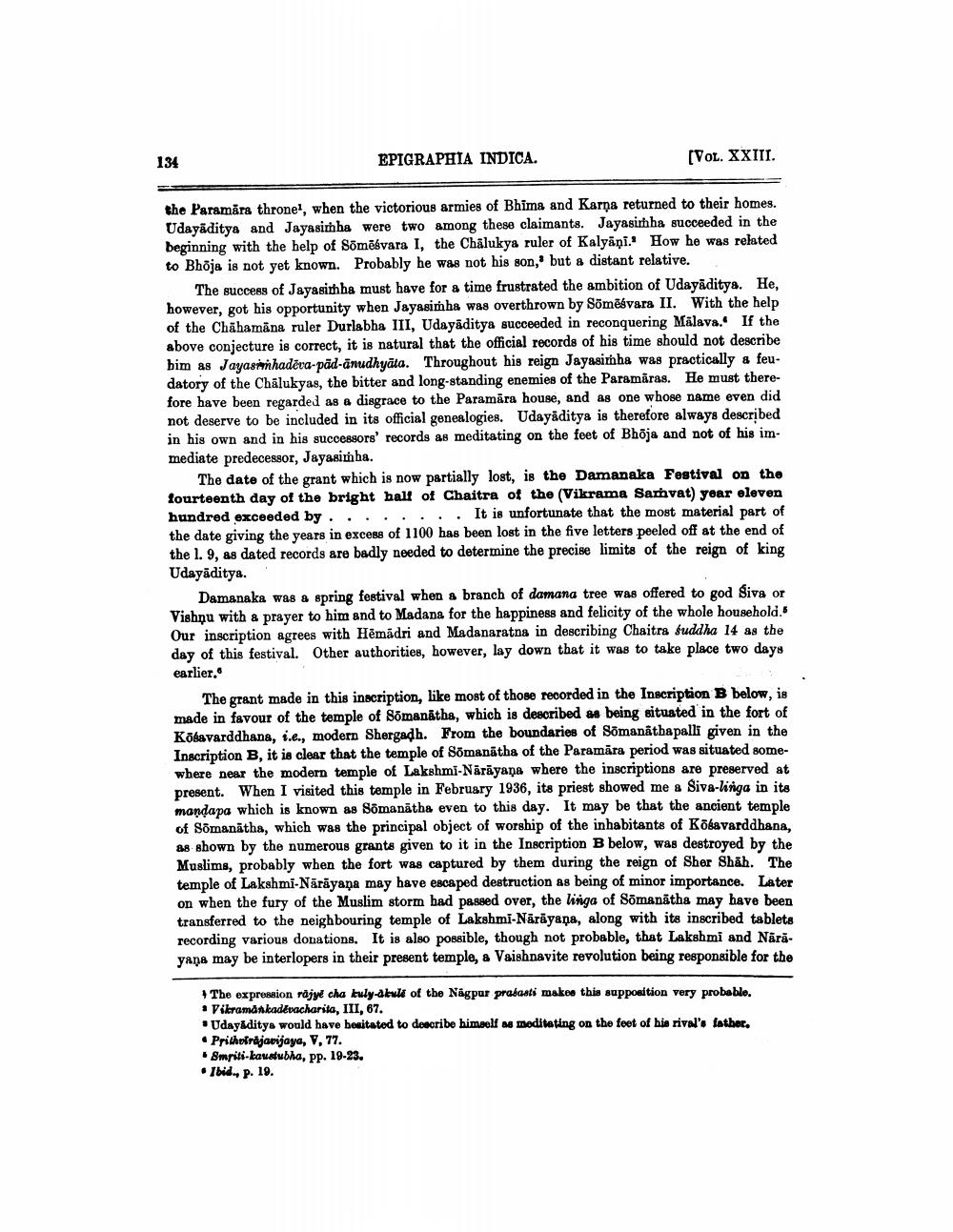________________
134
EPIGRAPHIA INDICA.
(VOL. XXIII.
the Paramära thronel, when the victorious armies of Bhima and Karna returned to their homes. Udayāditya and Jayasimha were two among these claimants. Jayasitha succeeded in the beginning with the help of Sömēsvara I, the Chalukya ruler of Kalyani.' How he was related to Bhöja is not yet known. Probably he was not his son, but a distant relative.
The success of Jayasitha must have for a time frustrated the ambition of Udayāditya. He, however, got his opportunity when Jayasimha was overthrown by Sömēsvara II. With the help of the Chāhamana ruler Durlabha III, Udayāditya succeeded in reconquering Mälava. If the above conjecture is correct, it is natural that the official records of his time should not describe bim as Jayasimhadēra pād-änudhyāta. Throughout his reign Jayasinha was practically a feudatory of the Chalukyas, the bitter and long-standing enemies of the Paramaras. He must therefore have been regarded as a disgrace to the Paramāra house, and as one whose name even did not deserve to be included in its official genealogies. Udayaditya is therefore always described in his own and in his successors' records as meditating on the feet of Bhöja and not of his immediate predecessor, Jayasimba.
The date of the grant which is now partially lost, is the Damanaka Festival on the fourteenth day of the bright half of Chaitra of the (Vikrama Samvat) year eleven hundred exceeded by........ It is unfortunate that the most material part of the date giving the years in excess of 1100 has been lost in the five letters peeled off at the end of the l. 9, as dated records are badly needed to determine the precise limits of the reign of king Udayaditya.
Damanaka was a spring festival when a branch of damana tree was offered to god Siva or Vishnu with a prayer to him and to Madana for the happiness and felicity of the whole household. Our inscription agrees with Hēmādri and Madanaratna in describing Chaitra suddha 14 as the day of this festival. Other authorities, however, lay down that it was to take place two days earlier.
The grant made in this inscription, like most of those recorded in the Inscription B below, is made in favour of the temple of Somanātha, which is described as being situated in the fort of Kõlavarddhana, i.e., modern Shergadh. From the boundaries of Somanathapalli given in the Inscription B, it is clear that the temple of Sõmanatha of the Paramāra period was situated somewhere near the modern temple of Lakshmi-Nārāyana where the inscriptions are preserved at present. When I visited this temple in February 1936, its priest showed me a Siva-linga in its mandapa which is known as Sömanātha even to this day. It may be that the ancient temple of Somanátha, which was the principal object of worship of the inhabitants of Kobavarddhana, 88 shown by the numerous grants given to it in the Inscription B below, was destroyed by the Muslims, probably when the fort was captured by them during the reign of Sher Shah. The temple of Lakshmi-Nārāyana may have escaped destruction as being of minor importance. Later on when the fury of the Muslim storm had passed over, the liriga of Somanitha may have been transferred to the neighbouring temple of Lakshmi-Nārāyana, along with its inscribed tablets recording various donations. It is also possible, though not probable, that Lakshmi and Närayana may be interlopers in their present temple, & Vaishnavite revolution being responsible for the
The expression rdjye cha kuly-dkult of the Nagpur prasasti make this supposition very probable. • Vikramankadevacharita, III, 67.
Udayaditys would have besitated to describe himself as meditating on the feet of his rival's father, • Prithvirajavijaya, V, 77.
Smriti-kaustubha, pp. 19-23. • Ibid., p. 19.




